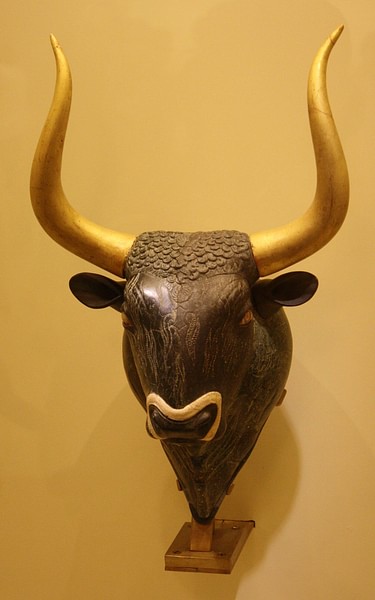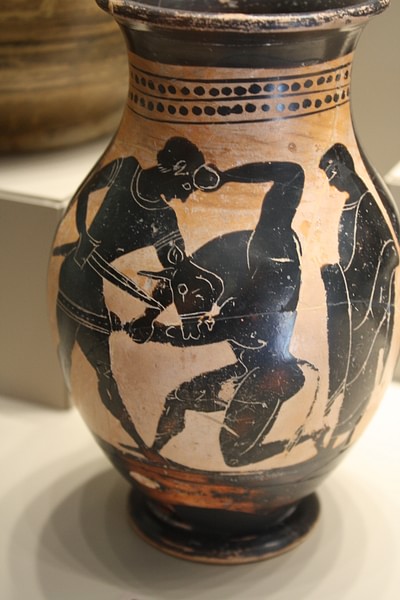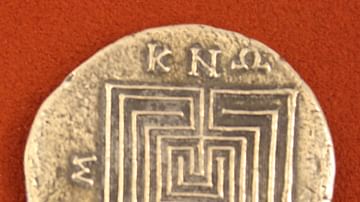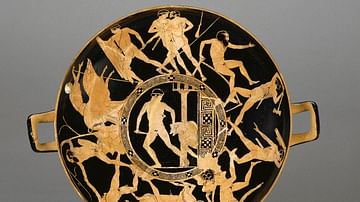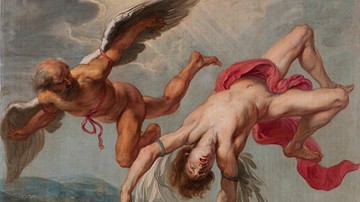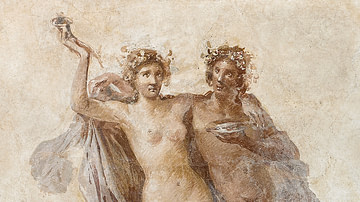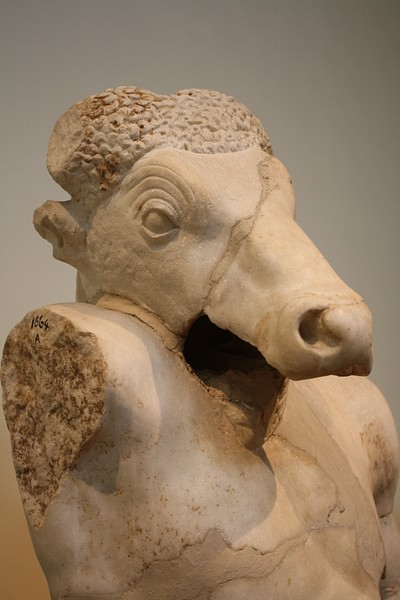
In Greek mythology, the Minotaur was a monster with the body of a man and the head and tail of a bull. The Minotaur was the offspring of the Cretan Queen Pasiphae and a majestic bull. Due to the Minotaur's monstrous form, King Minos ordered the craftsman, Daedalus, and his son, Icarus, to build a huge maze known as the Labyrinth to house the beast. The Minotaur remained in the Labyrinth receiving annual offerings of youths and maidens to eat. He was eventually killed by the Athenian hero Theseus.
The word Minotaur is a compound word consisting of the ancient Greek name "Μίνως" or "Minos" and the noun "ταύρος" or "bull." Thus, the word Minotaur comes to mean "bull of Minos." While, the Minotaur's birth name, Asterion, in ancient Greek "ἀστέριον" means "starry one" which suggests an association with the bull constellation: Taurus.
Minos & The Bull from the Sea
In Greek myth, Minos was one of the three sons from the union of Europa and Zeus; when Zeus was took the form of a bull. Europa's husband was the King of Crete, Asterion, who looked over the boys as if they were his own. When Aseterion died, it was unclear which of the three sons should ascend to power. The three sons were Minos, Sarpedon, and Rhadamanthus. It was Minos, whose name in Cretan actually means king, who was fated to be king of Crete even though Minos' ascension to power was a difficult journey because he first had to see off his sibling rivals. Minos, however, had one advantage that his brothers did not. He claimed that he had the support and authority from the gods to rule, and he boasted that he could prove it by praying for whatever he wanted and the gods would make it so. Thus, one day while sacrificing to Poseidon, he prayed that a bull would appear from the depths of the sea. Minos vowed to heaven that he would sacrifice the bull to Poseidon once it appeared. Poseidon, then, produced a magnificent bull from the sea; thus, Minos' claim for power was validated for no one dared to defy the favor of the gods, let alone the mighty Poseidon who ruled over all of the seas. As a result of winning the throne, Minos banished his brothers from Crete. The three brothers would be re-united in afterlife, for after they died they were made judges in the Underworld. It was their task to judge the dead in order to assign where their placement was in the Underworld based upon the merits of their life.
However, King Minos did not fulfill his vow to Poseidon; he kept the majestic Cretan bull for himself and sacrificed a different one to the god. Angered by King Minos' disrespect, Poseidon plotted to punish him for his arrogance and hubris. In accordance to some versions of the myth, it is Poseidon who punishes Minos by instilling a passion within the king's wife, Pasiphae, for the bull that came from the sea. However, according to the Roman author Hyginus, it is Venus (Aphrodite) who curses Pasiphae, because the Queen had not shown proper piety to the goddess for some time. The goddess punished her by sending a salacious passion for the majestic bull from the sea. Another version tells how Poseidon, angered by Minos, went to Aphrodite for her help in the matter and she cursed Pasiphae as a favor to Poseidon.
Pasiphae & the Birth of the Minotaur
Queen Pasiphae, plagued by her divinely inflicted desires, sought the help of Daedalus and Icarus. For Pasiphae, Daedalus constructed a wooden cow coated with a real cow hide and placed it upon wheels. Daedalus, then, put Queen Pasiphae inside the structure and wheeled her into the meadow that her beloved bull grazed in. It was there that she met and laid with the bull, since the bull thought the wooden cow was real. It is from this union that the Minotaur was born.
The queen named the beast Asterion (after King Minos' stepfather), which the Cretan people knew to be the Minotaur's true name. Upon seeing the infant, King Minos discovered his wife's bestial affair and as punishment, Minos enslaved Daedalus and Icarus for their parts in the affair, but he left Pasiphae untouched. Pasiphae cared for Asterion and was able to nourish Asterion while he was a bull calf. However, as he grew he became ferocious and monstrous and she was unable to feed or care for him any longer. Asterion was unable to find a suitable source of food, since he was neither man nor beast, and so he started to eat people. In order to hide his wife's disgraceful affair and on the advise of an Oracle, King Minos commanded Daedalus and Icarus to build a grand Labyrinth to house his wife's son: Asterion or Mintauros.
Death of Androgeos & Athen's Tribute
While the construction of the Labyrinth was underway, King Minos discovered that his only human son, Androgeos, (with Pasiphae) had been killed. Some sources say that he was killed by the Athenians out of jealousy for his skill in the Panathenic Games. A different version of the myth claims that the King of Athens, Aegeus, was angered by Androgeos' victories, and sent him to slay the unconquerable Marathonian Bull. In turn, he was killed by the bull and indirectly by the actions of the Athenians.
Regardless of how, Androgeos was killed and King Minos blamed the Athenians for the death of his only human son and for the destruction of his family line. He sailed against the Athenians and harassed them until they agreed to pay the price for his son's death. King Minos demanded that Athens pay a tribute to Crete of seven maidens and seven youths every nine years. (There is some contradiction in the sources about how often these tribute were made, from every nine years to once a year). These tributes would then be placed in the Labyrinth for the Minotaur to devour. In various sources, the tributes or sacrificial victims were chosen by lot from only the most beautiful men and virginal girls. The Athenians consulted the Oracle of Delphi who instructed the city of Athens to give Minos whatever he demanded. However, according to Catullus, the murder of Androgeos sparked a cruel plague on Athens. It is only when King Aegeus learned that by sending tributes to Crete and obeying Minos' demand that Athens would be saved; he agreed. Reluctantly, the Athenians submitted to Minos' terms and King Minos returned to Crete.
The Death of the Minotaur
Theseus, son of King Aegeus, was said to have volunteered for the third tribute of youths. He boasted to his father and to all of Athens that he would slay the Minotaur. He promised that on the journey home he would raise his white sails if he was victorious or have the crew fly black sails if he failed and were killed. Upon reaching Crete, the daughters of King Minos: Ariadne and Phaedra fell deeply in love with him. Unable to cope with Theseus being eaten by her half-brother the Minotaur, Ariadne went to Daedalus for help. She begged the craftsman to tell her how one could escape from his Labyrinth. Once he had told her, she raced to tell Theseus before he entered the Labyrinth. Following Daedalus' instructions, she handed Theseus a ball of thread to help him find his way out of the Labyrinth. Upon entering the Labyrinth, Theseus tied one end of the string to the door and continued into the maze. He found the Minotaur in the furthest corner of the Labyrinth and killed him with the jabs of his fist (or in other accounts, he sneaks in the sword of Aegeus and slays the Minotaur with it). Unlike the Labyrinth's previous victims, Theseus is able to find his way out, because of Ariadne's gift. Theseus simply follows the thread back through the maze to find his way to the doors. He finds and leads the other Athenians out of the maze and quickly sails off to Athens with Ariadne and Phaedra.
The Journey Home
On the journey home, Theseus abandons Ariadne on the island of Naxos and continues to sail to Athens with his intended wife, Phaedra. On Naxos, Ariadne reflects on her actions and naivety of assisting with her brother's murder (the Minotaur) for Theseus, who she thought would marry her. Instead of marrying Theseus, Ariadne is discovered on Naxos by the god, Dionysos, who she ends up marrying. In some versions of this myth, Dionysos appears to Theseus ordering him to abandon Ariadne, because he intends to wed her.
Theseus is overjoyed to be almost home with his new wife Phaedra but absent-mindedly forgets to change the color of his sails from black to white. His father, King Aegeus, seeing the black sails from afar is overcome with grief and kills himself by jumping off a cliff into the sea. It is this act which secures Theseus' place as the new Athenian king and explains the origin name of the Aegean Sea.
Art & Portrayal
The myth of Theseus and the Minotaur is seen in a wide array of pottery from antiquity. Most depictions show Theseus in battle with the Minotaur, who usually is in a submissive if not defeated role. It was a popular subject matter for art as the myth itself embodies the basic struggle between the natural and unnatural or the civilized versus the uncivilized, which is a common theme in many Greek artistic representations. There are also several coins from Crete which depict a bull head and the Labyrinth construction on the reverse side; this suggests that there may be some fact to this myth of the Labyrinth and Minotaur, most likely springing from a combination of the bull cult on Crete and the architectural complexity of their palaces.

